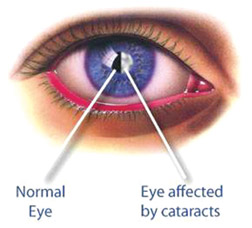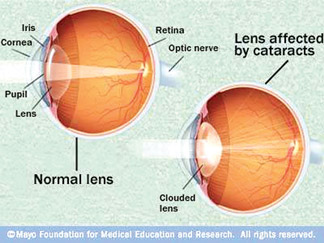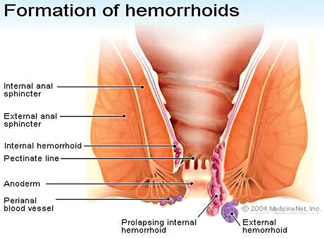|
Health Watch
Save your eyes! :
Cataract-causes and treatment
Nipuni WIMALAPALA
The main cause for 48 percent of loss of vision is due to cataract
according to the recent research data of World Health Organization. In
an interview with the Daily News Health watch Dr. Madhuwanthi
Dissanayake, Consultant Eye Surgeon and Senior Lecturer, Faculty of
Medicine, Colombo explains what causes cataract, its symptoms and
methods of treatment.
|

Dr. Madhuwanthi Dissanayake
Picture by Chaminda Niroshan |
As Dr. Dissanayake mentioned, the human lens is a naturally clear
structure located behind the iris and is supported by the zonules. The
lens does not have blood vessels or nerves. The basic lens consists of a
central nucleus surrounded by the cortex contained within the lens
capsule. When light passes through the pupil it is focused by the lens
to produce clear sharp images on the retina, the light sensitive
membrane of the back of the eye which functions like the film of a
camera. When this arrangement is disturbed in any way, the clear vision
is lost. As a result of scattering of light, blurring of the image will
occur. This is what happens in cataract.
“The human lens is made mostly of water and protein fibers which are
arranged in a precise manner to make the lens clear and allow light to
pass through without interference. With ageing the composition of lens
undergoes changes and the structure of the protein fibers breaks which
results in creating clouding areas of the lens and leading to the loss
of transparency. This loss of transparency or opacity formation is
called a cataract Dr. Dissanayake explained further.
According to Dr. Dissanayake, Cataract creates gradual, painless and
progressive loss of vision which takes place slowly. Patients are not
aware of it at the beginning since there is no pain, abnormal tearing or
any visible symptom. But as the cataract develops gradually the final
out come is loss of vision. In the early stages gradual loss of vision
can be seen. Vision becomes misty and blurred. It commonly affects
distance vision and also causes problems with glare. In early stages
stronger light and eyeglasses can help to deal with the vision problem
temporarily. Patients face difficulties when reading and driving. They
describe it as looking through a fogged-up window.
The main symptoms are;
* Blurred vision.
* Increasing difficulty with vision at night.
* Glare, especially at night.
* Halos around lights.
* Need of brighter light when reading.
* Double vision in a single eye.
* Fading or yellowing of colours.
Pain, redness and discharge are not the symptoms of cataract, but
when it is in the late stage these symptoms also can occur.
There are 3 main types of cataracts according to the site of the
opacity.
Subcapsular Cataract
 This
starts as a small opaque area just under the capsular shell, usually at
the back of the lens, right in the path of light on its way to the
retina. This type of cataract may occur in both eyes but can rather
develop in one eye earlier than in the other. This often interferes in
reading vision, reduces vision in bright light and causes glare or halos
around lights in the night. This
starts as a small opaque area just under the capsular shell, usually at
the back of the lens, right in the path of light on its way to the
retina. This type of cataract may occur in both eyes but can rather
develop in one eye earlier than in the other. This often interferes in
reading vision, reduces vision in bright light and causes glare or halos
around lights in the night.
Cortical Cataract
This begins as whitish, wedge-shaped streaks on the outer edge of the
lens cortex. As it slowly progresses the streaks extend to the centre
and interfere with light passing through the nucleus. Both near vision
and distance vision can be impaired. Patients have problems with glare
and loss of contrast.
Nuclear Cataract
Nuclear cataract occurs in the centre of the lens. In its early
stages the patient become more near sighted or even experience a
temporary improvement in reading vision. This so-called “second sight”
will disappear as the lens gradually turns yellow and begins to cloud
the vision. Seeing in dim light and driving at night may be especially
troublesome.
“According to the density of the cataract the classification goes as
early, moderate, mature and hypermature cataract. The danger of a late
stage cataract is can cause severe eye pain, redness (inflammation) and
headache. This is a relatively rare but an extremely painful situation
and needs surgical removal of the lens. When you consider the age of
onset of cataract, the congenital cataracts are extremely important
which is responsible for most of child patients who suffer from
cataract. This type basically has a family history of cataract or is
genetic. Infections like Rubella and toxoplasmosis are other causes.
When it comes to infants suffering from cataract, surgery must be done
as soon as possible. Otherwise after the maturation period of the brain
-eye development is over, it is really difficult to recover the vision
perfectly”, said Dr. Dissanayake.

Main cause
As she stated, the main cause for cataract is ageing. And also there
are some other reasons such as usage of drugs (eg. Steroids) or
medicines for a long time without being properly monitored by a doctor.
Suffering from diabetes also causes cataract. Exposure to sunlight,
cigarette smoking, trauma (blunt or penetrating), family history of
cataract, corticosteroid therapy, radiation exposure, electrical injury,
myotonic dystrophy and uveitis ocular inflammation may also cause
cataract.
Dr. Dissanayake stressed that the definitive solution or the
treatment for cataract is surgery. Cataract surgery should be considered
when changes in eye glasses help no longer, quality of life is
jeopardized and cataract removal is likely to have an impact on vision.
No medication can heal cataract, but can control the associated factors.
The main outcome of surgery is improvement of vision.
During the post operative period, the patient must take good care of
the eye. Patients should avoid dusty, crowded places and trauma and
should use the medications in the prescribed manner. If there is any
pain or redness of the eye, the patient should immediately contact the
surgeon and take advice.
Hemorrhoids and modern dietary patterns
H M P S Herath,
Department of Applied Nutrition, Wayamba University of Sri Lanka.
Hemorrhoids are swollen and inflamed veins around the anus or in the
lower rectum. The rectum is the last part of the large intestine leading
to the anus. The anus is the opening at the end of the digestive tract
where bowel contents leave the body. There are two types of hemorrhoids,
called as internal and external. Internal hemorrhoids develop in the
lower rectum and they may protrude through the anus. Most protruded
hemorrhoids shrink back inside the rectum their own. External
hemorrhoids are located under the skin around the anus.
Identification
The most common symptom of internal hemorrhoids is bright red blood
or stool, after a bowel movement. Internal hemorrhoids that are not
protruded are usually not painful. Protruded hemorrhoids often cause
pain, discomfort and anal itching. Blood clots may form in external
hemorrhoids. A blood clot in a vein is called a thrombosis.
 Thrombosed
external hemorrhoids cause bleeding, painful swelling around the anus.
When the blood clot dissolves, extra skin is left behind. Thrombosed
external hemorrhoids cause bleeding, painful swelling around the anus.
When the blood clot dissolves, extra skin is left behind.
This skin can become irritated. Excessive straining, rubbing or
cleaning around the anus may make symptoms.
Hemorrhoids are not dangerous or life threatening. Symptoms usually
go away within a few days. But, hemorrhoids are painful and irritated.
Therefore it can be a problem for the day to day activities of the
people.
Causes of hemorrhoids
Swelling in the anal or rectal veins causes hemorrhoids. Several
factors may cause this swelling.
1) Chronic constipation
2) Straining during bowel movement
3) Sitting on toilet for long periods of time
4) Lack of fiber in the diet
5) Ageing & pregnancy
Constipation
Difficult defecation with straining and hard or infrequent stools are
symptoms most often associated with constipation. Other symptoms
sometimes associated with constipation include, no urge to have bowel
movements, a sense of incomplete evacuation, anal and perennial pain,
soiling of cloths and discomfort.
Intestinal transit rate is the main factor that affects the
constipation. Slower intestinal transit rates responsible for increased
likelihood of constipation.
Other physiological factors that may contribute to constipation are
failure of relaxation of the anal sphincter, diminished rectal sensation
and disease such as hyperthyroidism, diabetes mellitus, Parkinson’s
disease, multiple sclerosis and spinal cord injuries.
Behavioural factors
Some behavioural factors may affect the hemorrhoids. Excessive
straining during the bowel movements and sitting on toilet for long
period of time will increase the pressure in the abdomen it will cause
hemorrhoids.
Aging and pregnancy
Weakening of the connective tissue in the rectum and anus occurs with
age and it may lead to the increased hemorrhoids during elderly ages.
Pregnancy can cause hemorrhoids by increasing pressure in the
abdomen, which may enlarge the veins in the lower rectum and anus.
For most women, hemorrhoids caused by pregnancy, disappear after
child birth.
To be continued
To avoid diabetes
At present main killer disease in Sri Lanka next to heart ailments is
diabetes. Regrettably people do n ot realize the danger. This is not a
rich man’s disease but even estate people are also suffering from
diabetics. Diabetes is a life time disease which cannot be cured but
could be controlled. The following are the cause of diabetes.
1. Hereditary
2. Obesity
3. Lack of exercise - rest both body and mind etc.
4. Mental Depression
5. Intake of too much of salt
6. Intake of strong drugs - side effects
The following suggestions are made
1. Consult your doctor and have a proper diet programme
2. Lead a balanced life - Exercise, rest, sleep etc.
3. Eat regularly
4. Please do not fast if you have diabetic
5. Check your body weight regularly
6. Take suggested drugs regularly under medical supervision - Please do
not select drugs from advertisement
7. Avoid salty, sweet and starchy foods.
8. There are items called sugar free food, but it may cause side effects
9. Intake of boiled vegetable, fish acceptable.
Diabetes could be controlled by flowing medication
1. Injection
2. Tables
Please ensure that these are taken under the supervision of a doctor.
It is always better to go for a medical checkup every 6 months.
S R Balachandran
B.Sc., FCA, FCMA (Sri Lanka)
Council Member - The National Chamber of Commerce of Sri Lanka |



